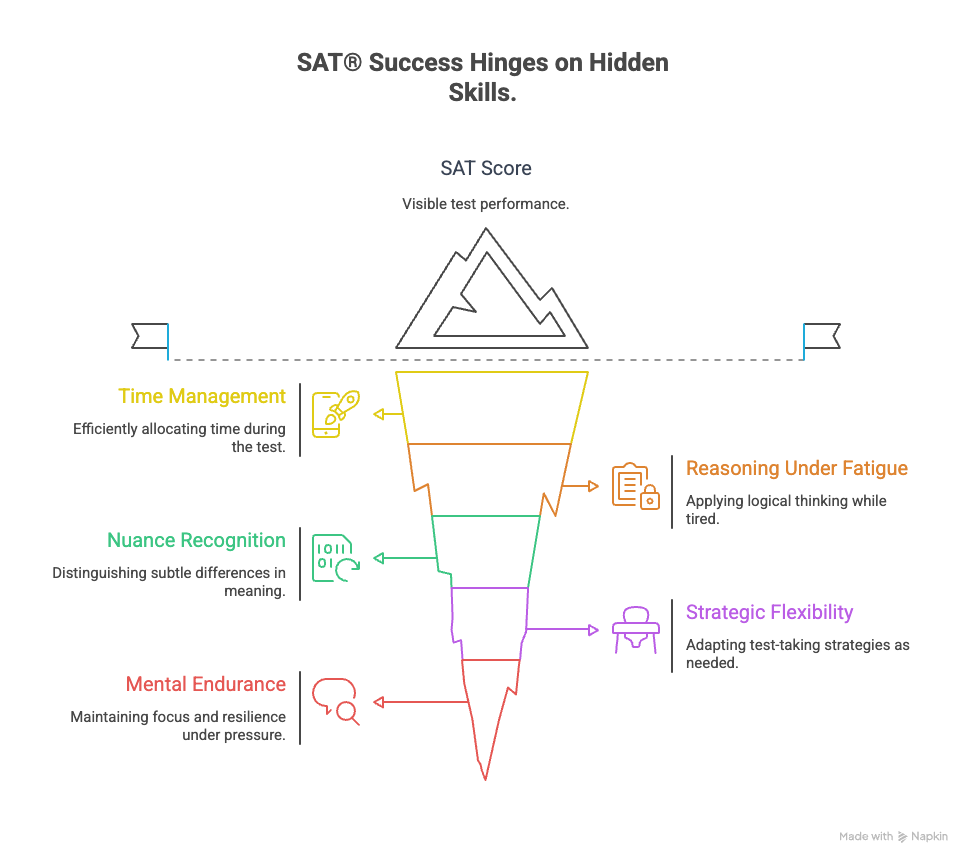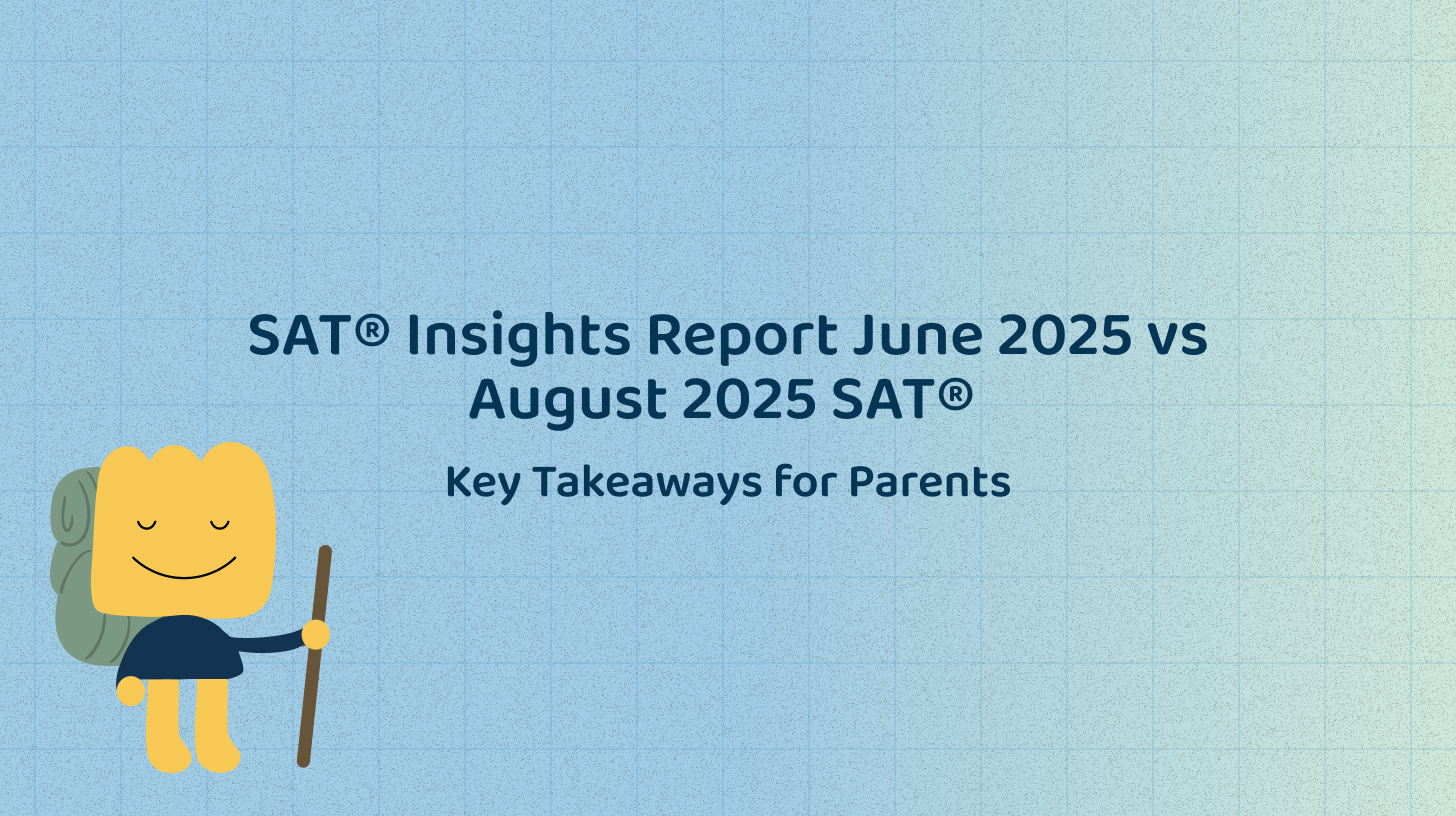Detailed Insights from the June 2025 SAT®
Reading & Writing
Module 1
- Vocabulary nuance questions (e.g., behold, exhaustive) confused many students.
- Some passages on language families, art, and architecture required contextual interpretation that students found tricky.
- Grammar items (punctuation and sentence structure) created uncertainty.
- Experimental/unfamiliar questions were noted, but overall Module 1 was manageable.
Module 2
- Students flagged transitions (“thus” vs. “furthermore”) as a pain point.
- Generalization and inference questions created hesitation, with many second-guessing.
- Vocabulary sets (eschew, impugn, heterogeneous) required careful nuance-reading.
- Passages requiring inference from studies (e.g., animal behavior) were tougher than humanities-based ones.
- Confidence was lower in Module 2, with many asking peers to validate their answers.
Math
Module 1
- Widely perceived as easier, with most students completing comfortably.
- Confidence was higher in answers compared to Module 2.
Module 2
- Geometry dominated : triangular prisms, pyramids, circle/arc problems, and trigonometry.
- Surface area/volume reasoning created confusion.
- Several students ran out of time after lingering on a few sticky problems.
- Probability and percentage questions tripped up some test-takers.
- Frustration was common, as many left questions blank due to timing debt.
Detailed Insights from the August 2025 SAT®
Reading & Writing
Module 1
- Vocabulary continued to be nuanced: attrition, analogous, copious, pervade, supersede.
- Grammar focused on punctuation and verb tense, often with subtle ambiguity.
- Reading questions included cultural references (e.g., Native Americans, tax havens) that required careful interpretation.
Module 2
- Transitions again caused confusion (admittedly vs. on the other hand).
- Inference-heavy passages (e.g., medieval city population density, insurance, economics) challenged students.
- Science/data passages, particularly on mycelium and temperature regulation, were flagged as harder.
- Longer passages increased time stress compared to Module 1.
Math
Module 1
- Generally viewed as straightforward and gave time for double-checking.
- Students noted alignment with practice expectations.
Module 2
- Cylinder and rectangular prism problems (surface area/volume) were central difficulties.
- Ratio/dimension problems in similar shapes created confusion.
- Probability, percentage, and word problems were perceived as harder than M1.
- Some noted scatterplot/data-interpretation items as confusing.
- Timing again emerged as the biggest issue.
Cross-Cutting Themes
- Module 2 consistently harder. Both Reading/Writing and Math M2 generated more stress, timing issues, and second-guessing.
- Vocabulary = nuance, not obscurity. Students struggle with near-synonym discrimination in context rather than rare words.
- Transitions, inference, and generalization are recurring weaknesses.
- Science/data passages > humanities passages. More confusion reported when interpreting methods, results, and implications.
- Geometry and ratios continue to dominate Math challenges, across different shapes (triangular prisms in June, cylinders in August).
- Stats/data literacy gap. Many struggled with scatterplots, regression, and sample-size logic.
- Bluebook gap. Students felt the practice tests underprepared them for test-day nuance, length, and complexity.
Differences Between June & August Themes
- June SAT® leaned heavier on triangular prisms, pyramids, and trigonometry in Math; August leaned on cylinders and rectangular prisms.
- June vocab included older academic terms (eschew, impugn, heterogeneous); August vocab leaned toward high-frequency academic words (attrition, analogous, copious, pervade, supersede).
- June science reading focused on language families and animal behavior; August science/data passages pushed into ecology, mycelium, and population studies.
- Overall, August Reading/Writing passages were described as longer and more draining than June.
Implications for Prep
Reading and Writing
- Prioritize transitions, generalization, inference drills, consistent weak points.
- Shift vocabulary prep from memorizing rare words to practicing near-synonym discrimination in context.
- Build regular exposure to science/data passages with one-question inference drills. For this, students can follow a SAT study plan that balances vocabulary nuance, inference practice, and timed reading sessions.
Math Preparation
- Emphasize geometry and solids reasoning (triangular prisms, cylinders, pyramids) with ratio → surface area → volume step-training.
- Train students in statistics/data literacy: scatterplots, regression, and “what the data can/cannot prove.”
- Enforce time-boxing protocols (skip after 40–50 seconds of no progress) to prevent timing collapse in Module 2.
- Mental math will always come in handy. Many students who followed strategies based on the best way to study for the SAT reported greater confidence with mental math and data-heavy problems.
Test Readiness
- Prepare students for Bluebook gap: real test is harder in vocab nuance, geometry, and passage length. Practice should simulate this.
- Build Module-2 stamina: simulate easy-to-hard progression within one sitting so students practice maintaining focus under fatigue.
- Normalize experimental-question anxiety: coach students to treat every question as real and not overthink during the test.
Strategy
- Work backwards when needed. Some students succeed by starting later questions to avoid early time sinks.
- Justification before lock-in. Encourage a quick “why this answer works” before committing to reduce second-guessing.
- Two-strike rule. If no clear plan in ~40 seconds, attempt once more, then skip. Saves time for solvable problems.
- Practice under fatigue. Place the hardest sets at the end of practice to simulate real Module-2 conditions.
- Calm resets. Build simple reset cues (e.g., “Breathe. Next question. Fresh start.”) to handle stress mid-test.
At this stage, many students and parents turn to guided platforms like Sherpalai for structured practice. If you are serious about improving performance before test day, you can Register Here and get access to adaptive prep tools and resources.
So What?
For parents, the key takeaway is this: the SAT® is no longer about memorizing tricks or obscure vocabulary. It’s about nuance, stamina, and smart strategy.
- The toughest parts of the exam, Module 2 in both Math and Reading/Writing, test whether a student can manage time, apply reasoning under fatigue, and distinguish between fine shades of meaning.
- Many students know the content but lose points because of timing missteps, overthinking, or lack of confidence in inference and generalization.
- Vocabulary is not about “hard words”, it’s about recognizing subtle shades of meaning (pervade vs supersede, analogous vs copious).
- Reading is not just about comprehension, it’s about spotting whether an argument is too broad, too narrow, or unsupported.
- Math is not just about formulas, it’s about choosing the right approach under pressure (ratio vs surface area vs volume, graphing vs algebra, when to skip).
- Knowing how to leverage Desmos will be critical.
- Practice alone is not enough if it doesn’t mirror the reality of test day: fatigue, pressure, long passages, and tricky wording.
Aha Moments for Parents
- It’s not that your child doesn’t know enough, it’s that the SAT® measures how they think under pressure.
- The biggest score leaks come not from knowledge gaps, but from hesitation, miscalibration, and time loss.
- Module 2 is a mental endurance test. Building stamina and decision-making resilience is as critical as content mastery.
- What feel like “silly mistakes” are often predictable choke points (transitions, inference, ratios, stats literacy), and they can be trained.
- The SAT® rewards flexible thinkers. Students who adapt strategies mid-test (skip, reset, re-approach) outperform those who grind through every question.





